
Yellowjacket or yellow jacket is the common name in North America for predatory social wasps of the genera Vespula and Dolichovespula. Members of these genera are known simply as "Wasps" in other English-speaking countries. Most of these are black and yellow like the eastern yellowjacket and the aerial yellowjacket ; some are black and white like the bald-faced hornet. Some have an abdomen with a red background color instead of black. They can be identified by their distinctive markings, their occurrence only in colonies, and a characteristic, rapid, side-to-side flight pattern prior to landing. All females are capable of stinging. Yellowjackets are important predators of pest insects.

Vespula is a small genus of social wasps, widely distributed in the Northern Hemisphere. Along with members of their sister genus Dolichovespula, they are collectively known by the common name yellowjackets in North America. Vespula species have a shorter oculomalar space and a more pronounced tendency to nest underground than Dolichovespula.

Vespula germanica, the European wasp, German wasp, or German yellowjacket, is a species of wasp found in much of the Northern Hemisphere, native to Europe, Northern Africa, and temperate Asia. It has spread and become well-established in many other places, including North America, South America, Australia, South Africa, and New Zealand. German wasps are part of the family Vespidae and are sometimes mistakenly referred to as paper wasps because they build grey paper nests, although strictly speaking, paper wasps are part of the subfamily Polistinae. In North America, they are also known as yellowjackets.

Dolichovespula is a small genus of social wasps distributed widely throughout the Northern Hemisphere. The yellow and black members of the genus are known by the common name yellowjackets in North America, such as Dolichovespula norwegica, along with members of their sister genus Vespula. In a study on the nesting biology of Dolichovespula, a colony of D. maculata with 771 workers was reported as having the largest recorded population count.
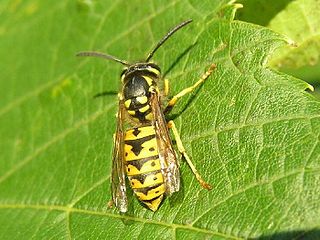
Paravespula is a small subgenus of yellowjacket wasps, including some of the best-known wasp species in the world: the German wasp, Vespula germanica; the eastern yellowjacket Vespula maculifrons; the western yellowjacket Vespula pensylvanica; and the common wasp, Vespula vulgaris. It is occasionally treated as a separate genus, but this is not widely accepted.
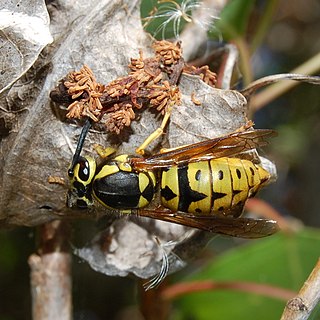
Vespula pensylvanica, the western yellowjacket, is a Nearctic species of wasp in the genus Vespula. It is native to regions of North America, largely in areas with northern temperate climates. Its reproductive behavior is constrained by cold weather, which successfully reduces the number of western yellowjackets in cold months. However, in the absence of cold weather, this wasp's population can explode. The western yellowjacket has become particularly invasive in the Hawaiian Islands, resulting in their label as a major pest.

The eastern yellow jacket or eastern yellowjacket is a wasp found in eastern North America. Although most of their nests are subterranean, they are often considered a pest due to their nesting in recreational areas and buildings. This yellow jacket is a social insect, living in colonies of hundreds to thousands of individuals. Along with their subfamily, Vespinae, this species demonstrates supportive parental care for offspring, separation of reproductive and sterile castes, and overlapping generations. They aggressively defend their hives from threats and are known to inflict painful stings.

Vespula flaviceps is a species of social wasp in the genus Vespula. It found in Eastern Asia and Japan. Studies have suggested that the queens of this species may mate with more males and use sperm more evenly. The reason for this is not yet well understood.

Vespula rufa, commonly known as the red wasp, is a social wasp species belonging to the genus Vespula. It is found in northern and central Europe, parts of Asia, and northern parts of North America. Vespula rufa is characterised by red-brown markings and body segmentation, with the appearance varying amongst the different roles of individuals in the species. These wasps build small nests in dry banks underground that are not far below the surface. The colony cycle begins in the fall. Vespula rufa feed on live insects. One interesting fact about Vespula rufa is that the queen policing occurs in the species, and that worker policing occurs at much lower rates than other species in the genus Vespula. There are predators and parasites of the species. The species goes through a series of events before leaving the nest.
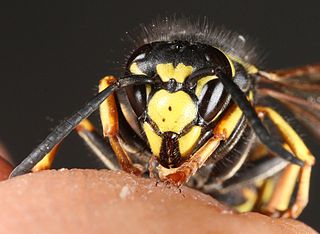
Vespula austriaca is an obligate parasitic wasp, parasitizing the nests of other species in the genus Vespula in the Old World. Its common host species include V. rufa in Europe, Japan, and East Siberia.V. austriaca wasps pollinate orchids.
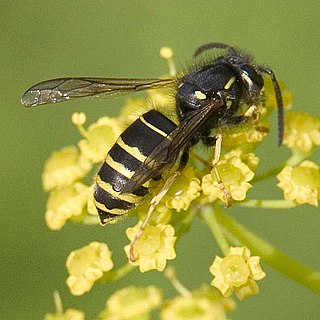
Vespula acadica, also known as the Forest Yellowjacket, is a North American species of eusocial wasp which is part of the "rufa" group within the genus Vespula. It is a black and yellow wasp that is found in arboreal areas and builds its nests most often in decaying vegetation like logs, but has occasionally been found to build aerial nests. Due to its preference for forests V. acadica does not normally come into contact with humans; however, when colonies are disturbed, workers of this yellowjacket may be quite aggressive and persistent and sting repeatedly.
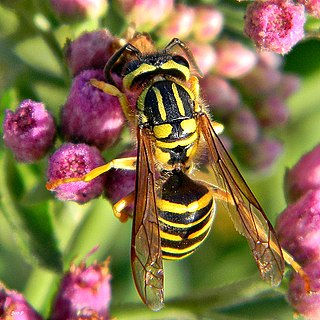
Vespula squamosa, or the southern yellowjacket, is a social wasp. This species can be identified by its distinctive black and yellow patterning and orange queen. This species is typically found in eastern North America, and its territory extends as far south as Central America. Within these territories, they create enormous, multiple-comb nests. The colonies may be either annual or perennial depending on the climate, and in many perennial nests, polygyny takes place. In addition, this species uses pheromones both as a sexual attractant and an alarm signal. This species feeds on insects and animal carcasses; it does not produce honey. V. squamosa, a social insect, has developed a parasitic relationship with the species V. vidua and V. maculifrons. Due to their painful, venomous stings, the species is considered a pest.

Dolichovespula arenaria, also known as the common aerial yellowjacket, sandhills hornet, and common yellow hornet, is a species of wasp within the genus Dolichovespula widely distributed in the North American continent.

Vespula atropilosa, also known as the prairie yellowjacket, is a black and yellow social wasp that forms annual colonies. Vespula atropilosa was formerly a member of the Vespa family. Males have either xanthic (yellow) or melanic (black) abdominal coloring. The prairie yellowjacket can be found in the Western and Midwestern United States as well as parts of southern Canada. It builds its nests underground and prefers large open areas such as pastures and golf courses. Vespula atropilosa colonies are founded by a queen in the spring and grow most during mid-summer. It preys on other insects such as flies and grasshoppers but is not a scavenger like other wasps. Queens mate with multiple males, and males will fight each other for matings. V. atropilosa is a social wasp that practices altruism. Prairie yellowjackets are not considered pests but are commonly found in backyards in the Pacific Northwest. This species derives its common name from the prairies and grasslands where it can be found.

Vespula alascensis, also referred to as common yellowjacket, is a species of yellowjacket that inhabits North America. Although it was named in 1870, it was, until 2010, treated as a taxonomic synonym of a related species, Vespula vulgaris, but is now recognized as a distinct taxon. Generally it nests in the ground.

Arphia is a genus of band-winged grasshoppers in the family Acrididae. There are at least 11 described species in the genus Arphia.
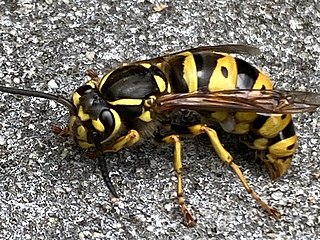
Vespula flavopilosa, also known as the downy yellowjacket, is a species of yellowjacket found in North America.

Vespula infernalis is an obligate parasitic wasp, parasitizing the nests of other species in the genus Vespula. Its common host species is V. acadica in North America. It is sometimes called the cuckoo yellowjacket wasp due to its inquiline lifestyle. They differ from other parasitic wasps in their intensely aggressive behaviour during invasion and occupation of the host colony. Several morphological adaptations such as bigger body parts and highly curved stingers are present in these wasps to aid their aggressive parasitic behaviour.
Vespula intermedia, the American red-banded yellowjacket, or the northern red-banded yellowjacket, is a rare species of wasp in the family Vespidae. It was described by Robert du Buysson in 1905. The species is native to northern Canada, Maine, and parts of Alaska, primarily the Canadian provinces of Yukon, Northwest Territories, Nunavut, British Columbia, Alberta, Saskatchewan, Manitoba, Ontario, Quebec, Newfoundland and Labrador, Prince Edward Island, Nova Scotia, and New Brunswick. It was listed as a synonym of Vespula rufa, but no clear evidence of its classification is present, with a mixed divide on its status from entomologists.
Vespula arisana, the Taiwan yellowjacket, or the Taiwan hornet, is a species of wasp in the family Vespidae. It was described by Jinhaku Sonan in 1929. The species is endemic to the island of Taiwan, where its range covers the entire island. Not much is known about the species, because of its exclusivity and endemicity.















